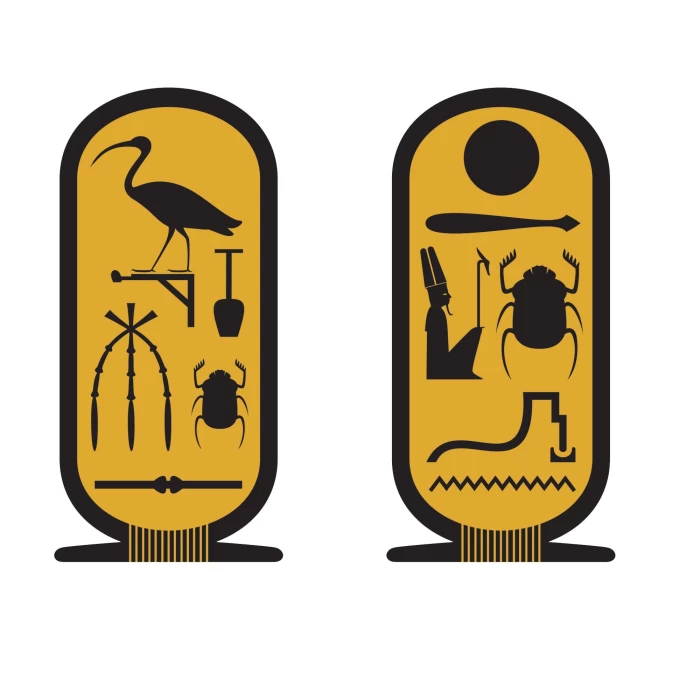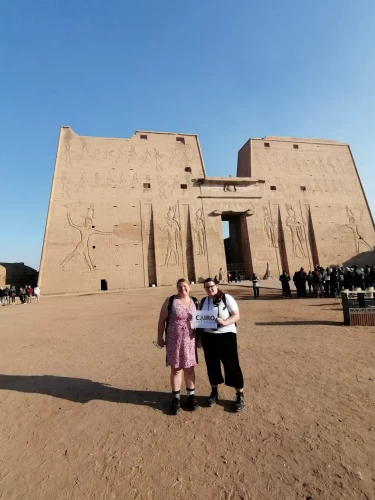
The Golden Cartouche
Ancient Egyptian Cartouche
If you want to be a king for Egypt as well you built a pyramid or your own tomb you have to put your title name in Cartouche, Cartouche it's not just a looped rope that has the name of the king written inside with magical power,
But it also protects the king's soul all his life then moves with the king to the afterlife to give him the power between the gods, then he could say his name then turns to be a god, and rest with them in paradise.
The mark
The cartridge means "Shenou" in the ancient Egyptian language. This name comes from the verb "Sheni," which means "to surround." As the primitive cartridge, it is found in the form of a circle that "circles" the king's name, and this circle represents the solar disc or everything that surrounds the sun, i.e. the pharaoh's world. Two interpretations are reasonable and correct. But this circle expanded and stretched fast until the full name of the pharaoh could be understood.
Egyptian Cartouche
So only a few round-shaped cartridges were made known. Old usage and description, We can find that the cartouches appear in a double cord knotted on both ends by means of a few bas-reliefs of King Sahi Ra of the Fifth Dynasty. As far as the king was concerned, he worked in the pyramid of Saqqara at the door of his funeral room with inscriptions with his new names and functions, followed by a round cartridge.
There is no doubt that during Pharaoh Senefru's reign the oldest cartouches that we know were surrounded by the king's name. The royal name (fifth in the list of titles and royal positions) has been mentioned in this regard.
The pharaoh's personal name was added to the cartouche frame during the reign of the Fifth Dynasty. Then the pharaoh's fourth and fifth names were always included in the range of the cartouches and, therefore, it was clear at first glance that the king had a certain building or origins.
We must admit that there is no new or new idea of registering the domain name in a form. The name of the king, or rather "Horus," was therefore written in the so-called serekh, an ornate facade of the palace or grave of the king, topped by the falcon Horus, and was certainly aforetime. The name is thus recorded in the first family. Here's the king's name "Narmer" on top of his famous painting, recorded in the Sarakht from ancient times.
Latest Articles
Admin
Seabourn Sojourn Cruise Stops in Safaga Port
The Seabourn Sojourn, the flagship vessel of Seabourn Cruise Line's ultra-luxury fleet, was built in 2008 at the T. Mariotti shipyard in Genoa, Italy. Measuring 198 metres, it can accommodate up to 450 guests in its 225 spacious all-suite staterooms.
Admin
Norwegian Sky Cruise Stops in Safaga Port
Norwegian Cruise Line operates a cruise ship called the Norwegian Sky. It was constructed in 1999 and can accommodate 2,004 passengers in addition to 878 crew members. The ship has several dining establishments, lounges and bars, a spa and fitness center, swimming pools, and a number of entertainment areas.
Admin
Explora II Cruise Stops in Safaga Port
Explora II, the second vessel in the Explora Journeys fleet, sets sail in 2024 to redefine luxury cruising. With 461 ocean-front suites, 9 culinary experiences, and 4 pools, this haven of sophistication and sustainability promises an unforgettable "Ocean State of Mind" journey to inspiring destinations.
Admin
Mein Schiff 6 Cruise Stops in Safaga Port
The Mein Schiff 6 is the latest cruise ship in the renowned TUI Cruises fleet, offering passengers a luxurious and sophisticated cruise experience. At 315 metres long, this floating resort features a range of dining options, entertainment, and recreational facilities, including a spa, fitness centre, and sports amenities.
Admin
Mein Schiff 4 Cruise Stops in Safaga Port
When the Mein Schiff 4 cruise ship docks in Safaga, Egypt, passengers are granted access to a realm of ancient wonders. Aboard this state-of-the-art vessel, guests can embark on meticulously curated shore excursions that showcase the region's most iconic landmarks, including the Giza Pyramids, the enigmatic Sphinx, and the remarkable tombs and temples of the Valley of the Kings in Luxor.
Admin
MS Europa Cruise Stops in Safaga Port
The Silver Moon, Silversea's latest flagship, is a luxury cruise ship that offers an exceptional travel experience for Venezuelans exploring Egypt. With a capacity of 596 guests and an impressive 40,700 gross tonnes, the Silver Moon maintains the small-ship intimacy and spacious all-suite accommodations that are the hallmarks of the Silversea brand.















